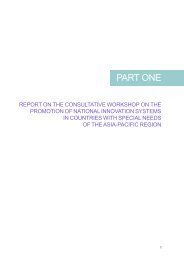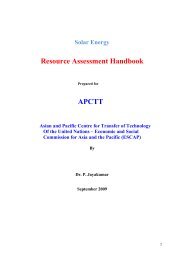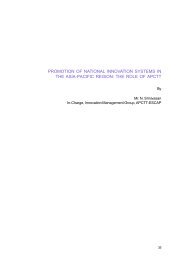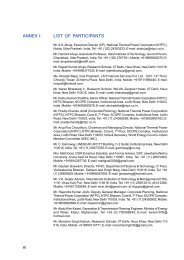• Ensuring not just easy FDI entry but also easy FDI exits; and• Effective intellectual property protection to encourage long-term FDI and the transferof innovative technologies.The presentation of Mr. Milicevic is given as Annex XI.Mr. D. Thomas Gochenour used the example of Ukraine vs. Russia, both of whichstarted from a similar position – a centralized power sector – and had substantial coalfiredsystems as of 1992. 4 The experience since 1992 has been highly contrasted.Russia liberalized the electric power sector, installed meters in the 1990s and beganto raise power tariffs. It also decided, by 2004, that it had to privatize the power generationsector in order to raise the investment capital needed to upgrade and expand thesystem. Russia felt it needed to do this because of the age of the power plants and theexpected strong demand growth that had already started to manifest. It completed thisprocess by 2008 and attracted some US$30 billion in new investment into the powersector, with four new state-of-the-art power plants being built since then.Ukraine, on the other hand, was slow to perceive the need for upgrading its powersector, even though coal was even more strategic for it than for Russia and the plantswere of the same age as that of Russia (also in poorer state of repair because ofUkraine’s relative poverty over the past 20 years). Ukraine does not have a policy tothis day for replacing or upgrading the old capacity and still does not seem to beconvinced that such a policy is needed before 2020. The country started privatizationof the power sector six years later than Russia and completed it only in 2012. Thisprivatization drive, however, did not attract new investment capital and most of thesystem was sold to one local oligarch at deeply knocked-down prices. Ukraine hasmaintained that the populace is too poor to afford the real market price of electricity.So an elaborate (and very costly) system of subsidization and cross-subsidies existsto this day with no definite plans in place to liberalize prices 5 , as political populisminsists on low energy prices. The power stations lost vast amounts of money for thepast several years and for nearly a decade hardly any new investment has come in.2. AfghanistanMr. Abdul Ghafar Rassin made a presentation titled “Investment Opportunities andOverview of Energy Sector in Afghanistan” and talked of the strong political commitmentthat exists currently in Afghanistan to foster FDI-led private sector growth, highlightingthe legal system that has been put in place to attract private investment. Afghanistanis a fast-growing economy with constitutional commitment to private investment andmarket economy. Hundred per cent foreign ownership is allowed and no discriminationis made between foreign and domestic investments. There is no restriction on inwardand outward capital flow and on profit and other cash repatriation. Import of capitalgoods and machinery is duty free and there is only 1 per cent duty on raw and intermediatematerials. He also highlighted financial incentives that an investor would receiveand pointed out the positive features of investing in Afghanistan. From an energyperspective these include: rapid economic growth and increasing demand for energy,4Russia has converted more of its power plants to gas-powered ones, and Ukraine hashad a large contribution from nuclear power generation.5Prices of both coal and electricity are set by the State.18
especially electricity; international partners supporting economic development; accessto regional markets; emphasis on improving physical infrastructure; and access tountapped world-class mineral resources such as oil, natural gas and coal. Total privateinvestment in Afghanistan amounts to US$8.9 billion, and FDI makes almost one-thirdof all investments. Besides energy, the other major sectors for investment are constructionand construction material, mining, services and agriculture/agro-processing.Afghanistan has three proven oil and gas basins and three potential basins. Theestimated reserves are 3.4 billion barrels of petroleum liquids, more than 450 billioncubic metres of natural gas and 443 million tonnes of high-quality coal.Only 30 per cent of all households have access to electricity and 70 per cent of theenergy demands are met through traditional biomass. Per capita annual consumptionis less than 60 kWh. Of the total installed capacity of 1,150 MW, hydropower provides52 MW, diesel generators 239.5 MW, thermal power 94 MW, small hydropower 75.14MW and renewable energy about 2 per cent. Energy imports – mainly from theneighbouring Uzbekistan, Tajikistan, Turkmenistan and Iran – amount to 465 MW or40 per cent.The power supply potential and projected demand are depicted in Figure 1-6. Afghanistanhas short-term, mid-term and long-term strategies for the electricity sector, and hasdeveloped appropriate policy framework. The short-term strategy stresses therehabilitation of the existent facilities and new power generation, mainly using generatorsets. In the medium term, the focus will be on energy trade (primarily import). Thelong-term strategy is to develop the country’s own energy resources to meet its demand,and renewable energy will be tapped to meet the demand in rural areas. The countryneeds to determine the required infrastructure for advanced FFTs for power generation.Figure 1-6: Potential supply of and projected demand for powerMW7,0006,0005,0004,0003,0002,0001,00006,200SupplyDemand3,5003,1001,7501,5001,000 1,0105202007 2008/09 2014 2020+Year3. ChinaMr. Antony Qinghua Zhang introduced the Shanghai Electric Power Generation Group(SECPG) by briefly outlining the company structure. The main products of SECPGare: 300 MW/600 MW sub-critical, supercritical and ultra-supercritical units; 1,00019
- Page 1 and 2: ADVANCES IN FOSSIL FUELTECHNOLOGIES
- Page 3 and 4: ADVANCES IN FOSSIL FUELTECHNOLOGIES
- Page 5 and 6: CONTENTSABBREVIATIONSiiiPART ONEREP
- Page 7 and 8: ABBREVIATIONSAC : Alternating curre
- Page 9: OECD : Organization for Economic Co
- Page 12 and 13: IORGANIZATION OF THE WORKSHOPA. Bac
- Page 14 and 15: D. Election of officersThe followin
- Page 16 and 17: IIICONSIDERATION OF ISSUESA. Backgr
- Page 18 and 19: emissions. Underground coal gasific
- Page 20 and 21: 800 MWe, a steam pressure of 300 kg
- Page 22 and 23: • Materials development & manufac
- Page 24 and 25: Figure 1-5: Strategy for commercial
- Page 26 and 27: tonnes, the state-owned enterprise
- Page 30 and 31: MW ultra-supercritical units; and s
- Page 32 and 33: the captive generation capacity) on
- Page 34 and 35: and other financial institutions -
- Page 36 and 37: and higher efficiency power generat
- Page 38 and 39: energy technologies, which can enab
- Page 40 and 41: • Such massive financial inputs c
- Page 43 and 44: BASELINE REPORT ON FOSSIL FUEL TECH
- Page 45 and 46: B. General R&D climate in the count
- Page 47 and 48: a convenient way to envisage energy
- Page 49 and 50: to mature and become more cost-comp
- Page 51 and 52: emissions, at least relative to sin
- Page 53 and 54: The Ministry of Power (MoP), which
- Page 55 and 56: 3. Bio-energyBio-energy, widely ava
- Page 57 and 58: in such a canal will rotate at a lo
- Page 59 and 60: in tackling climate change. A one p
- Page 61 and 62: Advantages of supercritical plants
- Page 63 and 64: existing power plants but also to b
- Page 65 and 66: BASELINE REPORT ON FOREIGN DIRECT I
- Page 67 and 68: CEA at 598 mt. This is mainly due t
- Page 69 and 70: For India to maintain its momentum
- Page 71 and 72: Table 2-5: Electricity generation t
- Page 73 and 74: Growth, which submitted its interim
- Page 75 and 76: 3. Future challengesThe future chal
- Page 77 and 78: development worked out. Public-priv
- Page 79 and 80:
Linking FDI to technology transferI
- Page 81 and 82:
The total requirement of fund durin
- Page 83 and 84:
Funding from multilateral agenciesM
- Page 85 and 86:
cooperation will be essential in so
- Page 87:
Planning Commission, Government of
- Page 90 and 91:
ANNEX I:LIST OF PARTICIPANTSMr. A.K
- Page 92 and 93:
Mr. S.C. Shrivastava, Joint Chief (
- Page 94 and 95:
ANNEX II:PROGRAMME6 June 2012, Wedn
- Page 96 and 97:
ANNEX III:AN OVERVIEW OF ADVANCED F
- Page 98 and 99:
• Technology solutions are also v
- Page 100 and 101:
Table 3-5: Improvement in cycle eff
- Page 102 and 103:
• No liquid effluent formation;
- Page 104 and 105:
Figure 3-5: Advancement of gas turb
- Page 106 and 107:
Figure 3-8: Goal 2 - New clean tech
- Page 108 and 109:
Compared with conventional power pl
- Page 110 and 111:
Figure 3-14: Thermax coal gasificat
- Page 112 and 113:
ANNEX VII:GE ENERGY AND ADVANCED FO
- Page 114 and 115:
ANNEX VIII:SWOT ANALYSIS OF FOSSIL
- Page 116 and 117:
By 2035, cumulative CO 2emissions f
- Page 118 and 119:
• Falling prices of renewable ene
- Page 120 and 121:
Figure 3-20: New advanced coal powe
- Page 122 and 123:
ANNEX X:ENERGY CONSERVATION: ERDA
- Page 124 and 125:
Table 3-11: Energy cost and intensi
- Page 126 and 127:
300Figure 3-23: Trends in coal use
- Page 128 and 129:
C. Gaps in coal use efficiencyFigur
- Page 130 and 131:
ANNEX XII:FINANCING OF THE POWER SE
- Page 132 and 133:
With the entry of many private sect
- Page 134 and 135:
for future requirements should be t
- Page 136 and 137:
Short supply of coal has started af
- Page 138:
Figure 3-35: Life-cycle of technolo







